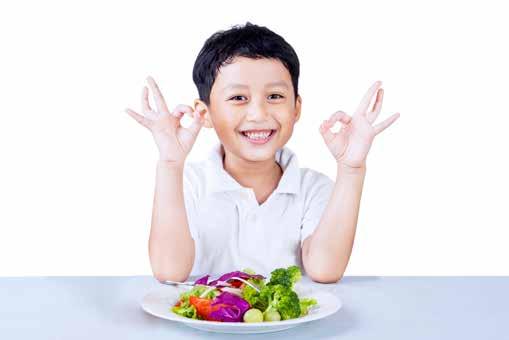
4 minute read
Helping Your Kids Maintain a Healthy Weight
Healthy Weight for Children
WRITTEN BY DIANE WHITTEN, MS, NUTRITION EDUCATOR, CORNELL COOPERATIVE EXTENSION SARATOGA COUNTY
If you have a child who is, or is heading towards being overweight, you must be wondering – how do I handle this?
According to the Academy of Nutrition and Dietetics at www.eatright.org, if your child is elementary age or younger, don’t talk about weight directly, just make lifestyle changes as a family. If you can deal with the situation as a family you won’t be singling out the child, putting him or her on the spot. Girls as young as six start talking about their weight, so if your young child or older child says something about being fat, use it as an opportunity to talk about being healthy, rather than being thin or fat. It’s best not to talk about weight loss, but on weight maintenance over time. Girls reach mature height in early teen years, boys may not reach mature height until late teens or early 20s, so for children who haven’t reached their mature height it’s possible that they will grow into their weight as they grow in height.
HEALTHY PORTIONS
Healthy eating includes not just what is eaten, but how much is eaten. Consider the portion size you serve your child. American portion sizes have increased significantly over the last few decades, both at home and at restaurants. Consider that a child-size burger at a fast food restaurant today is the size of an adult fast food burger served 40 years ago.

Vegetables
Grains
Meats & Other Proteins
Dairy 2-3 servings
6-11 servings
2 servings
1/4 cup cooked
1 cup milk, 1 ounce cheese, 3/4 cup yogurt
Adapted from Dietz WH, Stern L. eds. Nutrition: What Every Parent Needs to Know. 2nd ed. Elk Grove Village, IL: American Academy of Pediatrics; 2012:194.
Are you serving child sized portions? Portion sizes for children can be 50% smaller than for adults, while the portion sizes may not look drastically different at each age group, just 500 extra calories above what’s needed can result in a one-pound weight gain. Over the course of a week it’s easy to add an extra 500 calories, just by eating larger portions. HealthyChildren.org has a guide to portion sizes for different age groups. Here’s the link to children’s Portions and Serving Sizes.
HEALTHY FOOD
Healthy eating includes consuming a recommended number of servings of foods from different food groups, to get adequate vitamins, minerals, protein and carbohydrates. However, most Americans need to focus on eating less foods that are high in fat, sugar and sodium, such as chips, soda, baked goods, and fried foods. Make the healthy choice the easy choice by putting a fruit bowl on the kitchen counter for easy snacking.
BE A HEALTHY ROLE MODEL
Children learn more from what they see you do than from what you say. Be a role model for your child. Avoid making negative comments about your own or your child’s body. How you talk about yourself will impact how your child perceives him or herself. Model healthy food habits and exercise routines. When families exercise together you can establish activities that children can continue to enjoy into adulthood.
GATE KEEPER
The parent who does the meal planning and grocery shopping controls what food is available to children. Be sure to have healthy snack foods and make them handy to grab from the refrigerator, such as yogurt, or cut up vegetables with hummus. Plan healthy low-fat meals that will benefit the whole family.
EVALUATE YOUR CHILD’S WEIGHT
To evaluate your child’s weight, you can determine their Body Mass Index (BMI), a tool pediatricians use. You want to use a BMI chart or calculator developed for children. The website HealthyChildren.org, from the American Academy of Pediatrics, has a children’s BMI calculator to assess your child’s weight.
SF











